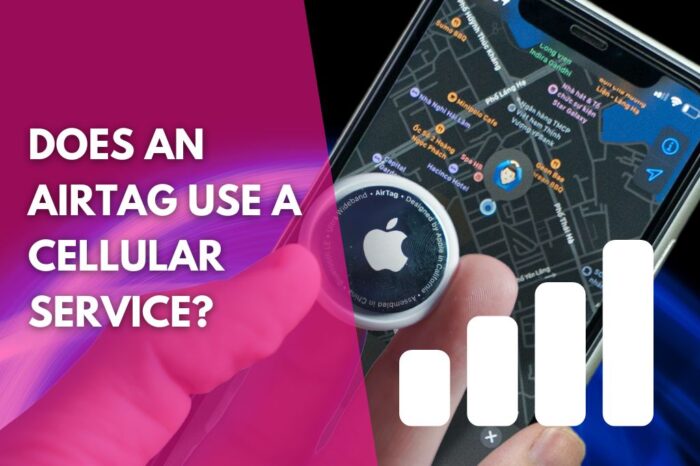Do you have an AirTag or, are you considering buying an AirTag and wondering, does an AirTag use a cellular service? If so, then this article is for you!
An AirTag does not need or use a cellular service. Instead, an AirTag uses Bluetooth to connect to nearby Apple devices in the Find My network to send data to iCloud.
In this article, I explain how an AirTag works without using cell service, how AirTags work without WiFi, and much more.

How Does An AirTag Work Without Cell Service?
An AirTag relies on nearby Apple devices in Apple’s Find My network. Through a Bluetooth connection, the nearby devices then send the AirTag’s location to iCloud where its tracked on the Find My app.
All this communication happens in an anonymous and encrypted way to protect your privacy, and all without using your cell data too. It’s important to note that only you can see where your AirTag is and, your location data and history are never stored on the AirTag itself.
To pinpoint an AirTag’s location to within tenth of an inch, an AirTag uses the Apple-designed U1 chip for Ultra Wideband which, allows for Precision Finding that includes distance and direction. Apple’s Precision Finding on an AirTag is compatible with an iPhone 11 or greater with iOS 14.5 or later installed.
How Does An AirTag Work Without Internet?
An AirTag works without internet by send anonymous, secure Bluetooth signals to nearby Apple devices in the Find My network. These devices then send the AirTag’s location to iCloud so the AirTag can be seen on the Find My app.

If an AirTag is no longer within Bluetooth range of your device, it will leverage other Apple devices on the Apple Find My network and use those devices to broadcast its location. An AirTag doesn’t use WiFi as a communication protocol. Instead, an AirTag uses Bluetooth to communicate with other devices.
If your AirTag is close to you, your Apple device, using Precision Finding, will lead you straight to it. Precision Finding uses Ultra Wideband technology to provide spacial and directional information on supported Apple devices.
However, if your AirTag is not near, your AirTag can also be put into Lost Mode, just like other Apple products. When your AirTag has been found by other Apple devices close by, you will immediately receive a notification of its whereabouts.
How Accurate Is An AirTag’s Location?
An AirTag’s location is extremely accurate. An AirTag uses Ultra Wideband, a short-range wireless communication protocol. However, unlike Bluetooth and WiFi, Ultra Wideband operates at a much higher and broader frequency range and is capable of giving highly accurate spatial and directional data points.

Using Apple’s Precision Finding coupled with Ultra Wideband data, you can track and locate your AirTag to within inches or less of its exact location, making an AirTag a very effective tracking device.
One point to note, however. Precision Finding is only compatible with the iPhone 11 or greater and iOS14.5 or later. A full list of AirTag technical specs is available from Apple.
What Is AirTag Lost Mode?
AirTag Lost Mode is an Apple feature that, when discovered by another Apple device on the Find My network, a notification is sent to the AirTag owner. Additionally, an NFC-capable device can be used to tap on the AirTag to view a Lost Mode message like owner contact information.
Lost Mode is not a new concept, nor is it only available on an AirTag. Most other Apple devices also have this feature. When you enable Lost Mode on an AirTag, you can enter details like a phone number, email address, or even a personal message for the finder to help with retuning the AirTag.
Naturally, if you find your AirTag then you will want to turn off Lost Mode as soon as possible. Turning off Lost Mode is just as easy as turning it on and, once turned off, this no longer identifies your AirTag as lost and ensures you will no longer receive notifications.
Frequently Asked Questions
Hopefully, I have answered all of your questions on, does an AirTag use cellular service. However, you may still have other questions surrounding Apple AirTags. If you do, below, I answer some common frequently asked questions or check out one of my other articles like do Airtags have a monthly fee.
Can you turn an AirTag on and off?
Is the battery in an AirTag replaceable?
Are AirTags compatible with Android devices?
Does an AirTag work without cell service?
Final Thoughts On Does An AirTag Use A Cellular Service
So, in conclusion. Does an AirTag use a cellular service? No. AirTags do not use cellular service, nor do they need cellular data. AirTags use Bluetooth to communication with other nearby Apple devices in the Find My network to send their location to iCloud where it can be seen in the Find My app.
Are you looking for ideas on where you can use Apple AirTags? Check out my other article on cool AirTag ideas. Now, where did I put my wallet again?
